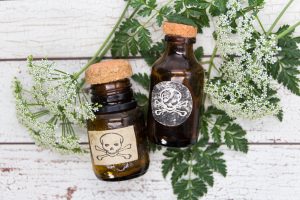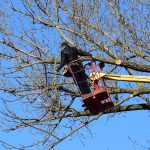The Most Poisonous Trees in the World
The 5 Deadliest Trees and Plants in the World
Most of the time, trees are pretty harmless. We are safe to stand beneath them and marvel at their beauty. The trees on this list, however, could kill you if you get too close. Here’s a list of the most poisonous trees.
1. The Manchineel: One of the World’s Most Poisonous Trees
Look at this tree. It seems like a typical tree, right?
Wrong. It’s actually one of the world’s most poisonous trees.
This tree grows throughout the southern Americas and the Caribbean. It is so dangerous that authorities often place warning signs to caution people away from it.
What in the world? A tree of death?
That’s precisely it. The world is filled with wonders and curiosities, so we should never be surprised by the fact that much of it is off-limits to humans.
One such curiosity is the tree pictured in the link above: the manchineel (Hippomane mancinella). Also known as the beech apple (sometimes misspelled as beach apple) or poison guava, danger emanates from all parts of the tree.
First of all, the fruit — the manzanilla de la muerte or “little apple of death,” in case you weren’t convinced of the danger — is slightly sweet. But it’s very bad to eat the fruit. Just a small bite will cause boils to form in your mouth and throat. Swallowing it could kill you.
Today the manchineel tree is an endangered species in Florida. And humans might be, too, if they don’t heed the warnings.
Nicola’s Story
Nicola, a radiologist on vacation found out the hard way that the manchineel is not to be trifled with.
“I rashly took a bite from this fruit and found it pleasantly sweet,” Nicola told the National Center for Biotechnology Information. “My friend also partook (at my suggestion). Moments later we noticed a strange peppery feeling in our mouths, which gradually progressed to a burning, tearing sensation and tightness of the throat. The symptoms worsened over a couple of hours until we could barely swallow solid food because of the excruciating pain and the feeling of a huge obstructing pharyngeal lump. Sadly, the pain was exacerbated by most alcoholic beverages, although mildly appeased by pina coladas, but more so by milk alone.”
If you like pina coladas and getting caught in the rain under a manchineel tree …
“The manchineel tree,” write the authors of a 1993 study, “is found in the West Indies, Central America, the Bahamas, South America, and the west coast of Africa. It has been described as the most toxic tree on the North American continent and so in the United States it is allowed to grow only in the Everglades of Florida and the Virgin Islands National Park.”
Why Grow It?
Why allow it to grow at all, you may ask? The authors answer that question, as well.
“The tree is capable of flourishing in a highly saline environment,” they write, “and is therefore usually found in coastal regions. It has an extensive root system which has led to planting in an effort to prevent coastal erosion.”
This tree is extremely poisonous and is considered the world’s most dangerous according to Guinness World Records. Need more evidence? The tree produces sap that will cause blindness and blistering of the skin should it come into contact with a person or animal.
Even standing beneath the tree in the rain can result in skin blistering, and encountering smoke from burning manchineel wood can cause blindness.
So if you’re vacationing in the Caribbean, in southern North America, or northern South America, beware! This is one diabolical apple tree.
But there are others.
2. ‘The Suicide Tree’: Cerbera Odollam
The seed of the Cerbera odollam has reportedly been used in more suicides and murders than any other plant. The tree is native to India and other parts of southern Asia and contains a toxin called cerberin. This potent compound disrupts the function of your heart muscles, leading to an irregular heartbeat that can be fatal if enough cerberin is ingested.

Cerbera odollam (aka “the suicide tree”)
Because the flavor of this poisonous plant is easily disguised in food, and the toxin is notoriously overlooked by medical examiners, some refer to cerberin as the perfect murder weapon. In fact, between 1989 and 1999, Cerbera odollam reportedly caused more than 500 deaths in the southwest Indian state of Kerala alone.
Symptoms of Cerbera odollam poisoning include burning sensations in the mouth, vomiting, headache, irregular heartbeat and respiration. It can even lead to coma and, as noted above, death.
The fruit of the suicide tree is not without its uses, however. Scientists manufacture bioinsecticides, deodorant, and, potentially, feedstock for use in the production of biodiesel. So despite being one of the most poisonous trees, it does have at least some benefits.
3. The Bunya Pine
This tree — although not one of the most poisonous trees — can certainly be deadly. Historically, however, it has also given life to its surroundings. The bunya pine, or Araucaria bidwillii, has existed since dinosaurs roamed the earth and is now found almost exclusively in Queensland Australia.
Every few years, bunya pine trees are known to drop extremely large cones weighing up to 40 pounds each — a particular danger to unsuspecting passersby.
These super-sized cones can be fatal when falling. Still, these living fossils have offered native people an indispensable source of food for hundreds of years. Feasting on the nuts produced by the cones has inspired gatherings where tribes perform ceremonies, trade goods, settle disputes, and arrange marriages.
4. Conium maculatum (Hemlock)
We’re talking about the most poisonous trees and the most poisonous plants. This historically significant species should definitely make the list.
Hemlock was widely used in ancient Greece as a means of execution and suicide, claiming its most famous victim when the philosopher Socrates took his own life in 399 BC.

Photo illustration of hemlock flowers with a vial of poison.
Plato described Socrates in his “Phaedo”:
The man laid his hands on him and after a while examined his feet and legs, then pinched his foot hard and asked if he felt it. He said “No”; then after that, his thighs; and passing upwards in this way he showed us that he was growing cold and rigid. And then again he touched him and said that when it reached his heart, he would be gone. The chill had now reached the region about the groin, and uncovering his face, which had been covered, he said — and these were his last words — “Crito, we owe a cock to Asclepius. Pay it and do not neglect it.” “That,” said Crito, “shall be done; but see if you have anything else to say.” To this question he made no reply, but after a little while he moved; the attendant uncovered him; his eyes were fixed. And Crito when he saw it, closed his mouth and eyes.
Ingesting even small amounts of coniine, the plant’s potent toxin, will cause ascending muscular paralysis. The paralysis could eventually reach the respiratory muscles and result in death.
This deadly tree is native to the temperate Mediterranean. It’s considered a noxious weed in 12 U.S. states, including Oregon and Washington. Here’s what you can do if you find it.
5. The Sandbox Tree: Hura crepitans
The sandbox tree grows throughout the Americas and belongs on any list of the most poisonous trees. (Some people call it the “monkey no-climb” due to the spikes on its trunk.) The sap is poisonous and can cause nasty rashes. Bizarrely, when the fruit of the sandbox matures, it explodes, sending seeds in all directions at upwards of 160 miles per hour! This has led some folks to refer to it as the dynamite tree.
Fishermen use the milky sap to poison fish. The Caribs people poisoned their arrowheads with it.
Get in touch with Inexpensive Tree Care with any questions.




